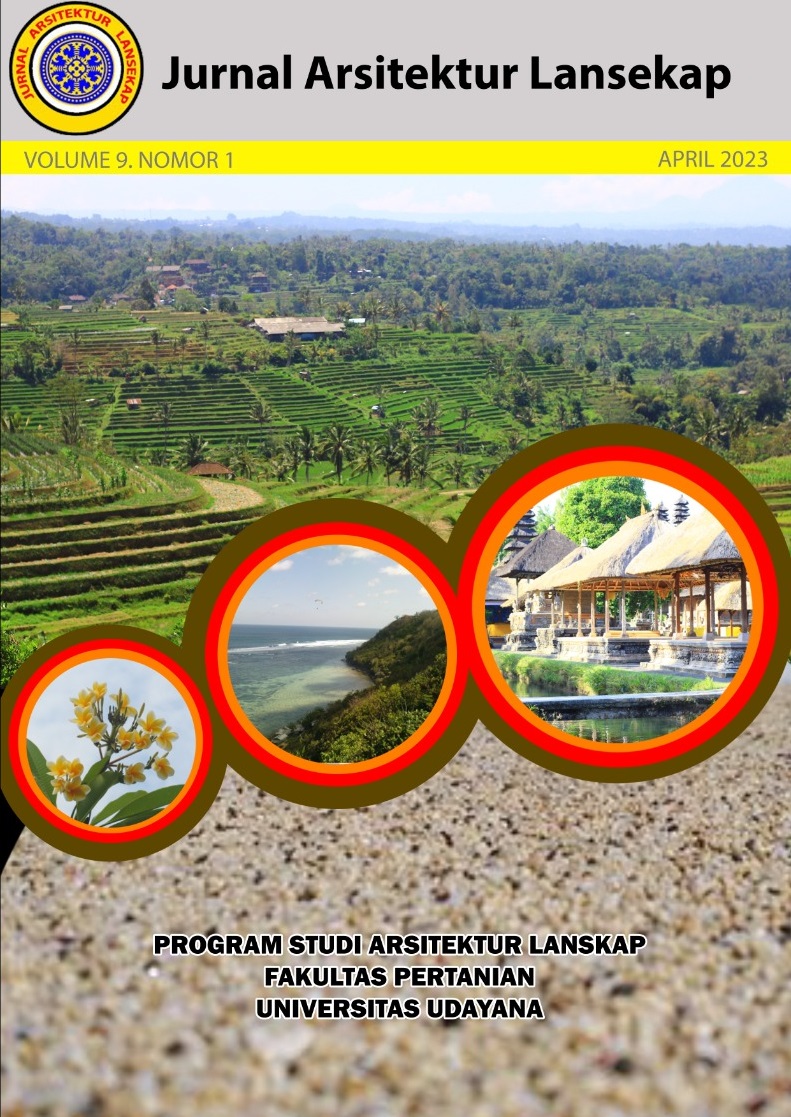Konsep Desain Jalur Interpretasi Wisata Sejarah Mads Lange di Hilir Tukad Mati Kuta Badung
Abstract
Conceptual Design of Historical Tourism Interpretation Route of Mads Lange in Downstream Tukad Mati Kuta Badung. Downstream of Tukad Mati is a historical location related to the development of Kuta. In the past, this downstream was a pier called Jangkong pier. Mads Lange was known to have businesses that had been part of Kuta development at that time. Mads Lange was a Danish trader who lived in Kuta from 1839 and also died in Kuta in 1856. There are three locations related with Mads Lange in Tukad Mati downstream, those are; the Jangkong former pier associated with the trading activities, the former houses and factories of Mads Lange which are currently become Pasar Senggol Kuta (Kuta community market) and the Alron Hotel, and the Mads Lange’s grave. This study aims to transform the story of Mads Lange during his time in Kuta and adapt it into historical tourism program that is an interpretation route design concept. The research method of this study is a survey method in which the data collected by using observation, interviews and literature studies. Descriptive analysis is used for data processing with four stages: preparation, data inventory, synthesis analysis, and design concepts. The basic concept generated in this research is the utilization of the historical story of Mads Lange as a branding of the tourist interpretation in Tukad Mati downstream. The concept of interpretation facilities is carried out by adding interpretation facilities, such as: interpretation media, information centers, and making a replica of the pier. In addition, supporting facilities are also added speed table, river walk, directions, parking, gates, seating, and a foodcourt. For the lighting concept, namely the concept of welcome light on the gate, guiding light, and lighting for interpretation. The concept of interpretation route is designed by integrating some of existing tourist attractions and some others facilities and elements of design required. The conceptual design of historical route of Mads Lange starts from the gate, information center, Mads Lange grave, Mads Lange chest sclapture, dalmantion dog sclapture, Jangkong replica, river landscape, foodcourt, and ending at the plaza.
Downloads
References
Agung, A. A. G. P., et al. (1986). Sejarah Kota Denpasar 1945-1979. Departemen Pendidikan dan Kebudayaan. Direktorat Sejarah dan Nilai Tradisional.
Balai Pelestari Daerah Aliran Sungai Hutan Lindung Unda Anyar. (2020). Data Topografi wilayah Kuta. Balai Pelestari Daerah Aliran Sungai Hutan Lindung Unda Anyar Bali.
Bloch, P. (2007). Mads Lange-The Bali Trader and Peacemaker. Bali Purnati Center, Hardback.
Howard, P. 2003. Heritage: Management, Interpretation, Identity, New York, Continum.
Ishomudin, A. (2017). Analisis Bangunan Pengendali Banjir di Sepanjang Sungai Tukad Mati Provinsi Bali. [Politeknik Negeri Bali].
Nugroho, P., A. (2019). Interpretasi Wisata Alam, Perencanaan Interpretasi Wisata alam Terpadu dan Mandiri. Yogyakarta: Deepublish Publisher.
Simonds, J.O. (1983). Landscape Architectur: A Manual Site Planning and Design. McGraw-Hill Book Co. New York

This work is licensed under a Creative Commons Attribution-ShareAlike 4.0 International License.
An author who publishes in the Jurnal Arsitektur Lansekap (JAL) agrees to the following terms:
- Author retains the copyright and grants the journal the right of first publication of the work simultaneously licensed under the Creative Commons Attribution-ShareAlike 4.0 License that allows others to share the work with an acknowledgement of the work's authorship and initial publication in this journal
- Author is able to enter into separate, additional contractual arrangements for the non-exclusive distribution of the journal's published version of the work (e.g., post it to an institutional repository or publish it in a book) with the acknowledgement of its initial publication in this journal.
- Author is permitted and encouraged to post his/her work online (e.g., in institutional repositories or on their website) prior to and during the submission process, as it can lead to productive exchanges, as well as earlier and greater citation of the published work (See The Effect of Open Access).
Read more about the Creative Commons Attribution-ShareAlike 4.0 Licence here: https://creativecommons.org/licenses/by-sa/4.0/.







